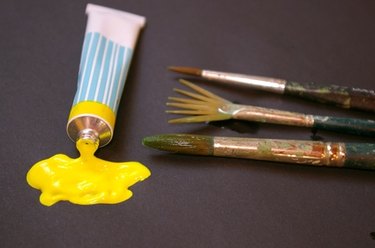Things You'll Need
Studio or room
Art supplies

In private art lessons it is possible to teach drawing, painting and sculpture. This profession can be taken up by anyone, not just professional artists. There are some major requirements such as having some artistic talent and patience. Even very prestigious artists can feel fear at teaching for the first time, and it is normal to be nervous. However, if you are the kind of teacher who can enjoy the intensity of a one-on-one session, then no doubt you will flourish in the environment of giving private lessons.
Step 1
Consider your experience. If you have a bachelor's degree in art or a master's in art education, you can charge more because your pupils will expect more from you. However, having a fine-arts degree does not necessarily make you a good artist, so be prepared to show your potential student your skills.
Video of the Day
Step 2
Be prepared to demonstrate your worth as a teacher. Perhaps you have an master's in Education or you are experienced with children. If not, expect to be on a learning curve as you begin to practice private arts teaching to either children or adults.
Step 3
Phone other arranged classes offered such as those in karate, yoga and music lessons in your area to see what they charge. Price your lessons similarly.
Step 4
Set up a studio or a room in your home that is well lighted and ventilated. The space should be large enough for you and a student as well as supplies. Studio usage usually costs 25 percent of your fee. Consider renting a room in your local church. Some churches may not charge you for the room.
Step 5
Loan art supplies to teach with instead having the student work with average art supplies typically available in major supermarkets. If you are loaning your own supplies expect to charge more than if student brings his own.
Step 6
Supply tea and coffee for lessons lasting longer than 1 hour. One hour is suitable for watercolor or drawing classes, but three hours is more appropriate for oil painting.
Step 7
Demonstrate art techniques. Start by critiquing last week's homework for 15 minutes for example, and then demonstrate a new artistic technique. For example introduce types of color wheels and teach the student how to mix colors. An artist should also learn observation and how to create shadow.
Tip
A commercial illustrator is not the same as a fine artist. A fine artist cannot teach commercial art and reproduction, but a commercial illustrator will know all the technical lingo that goes into making commercial illustration commissions. If your child is interested in commercial art, he should be taught by a commercial illustrator.
Warning
You may be expected to help compose an admissions portfolio for a young person trying to get into art school. If so, make sure you research the relevant art school’s admissions procedure and what it requires from potential students.
Video of the Day